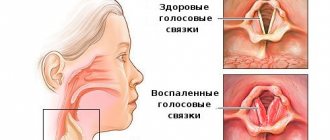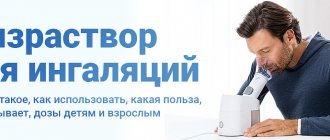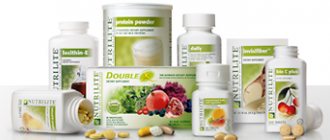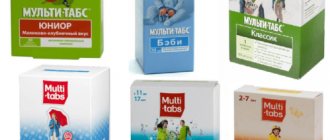Can vitamins strengthen a child’s immunity?
advises a medical pediatrician How to properly protect a child from colds with the help of vitamins and nutritional supplements is a question that worries every mother.
Indeed, there are a number of vitamins, minerals and products containing them, the inclusion of which in a child’s diet is necessary to maintain the child’s health. All parents have likely seen advertisements for products and supplements that claim to boost a child's immune system to help prevent colds and flu. Typically, these “immune-boosting” products include vitamins, multivitamins, and probiotics. However, this approach advertised by pharmaceutical companies is not entirely scientific. Although some vitamins have been found to alter some components of immune function, there is still no evidence that they actually strengthen the immune system to the point that a child will be better protected from infections and diseases.
From a scientific point of view, the opposite thesis is true:
Lack of vitamins may contribute to increased morbidity. Various micronutrient deficiencies - such as zinc, selenium, iron, copper, folic acid and vitamins A, B6, C, D and E - do play a role in the development of some diseases. Vitamins can help prevent disease and other health problems, but only in children and adults with severe vitamin deficiencies.
It is important to know: vitamins will do little to help you stay healthy if your child is already healthy. This means that an increased level of fortification will not contribute in any way to “increasing” the child’s immunity. Vitamins can support healthy immunity, but do not “strengthen” it.
More vitamins than you need does not mean “better”! In some cases, an overdose of vitamins can cause harm to the body due to a toxic “cumulative” effect or hormone-like effect, and can cause hypervitaminosis.
What are vitamins?
A very precise definition of vitamins was given by Albert Szent-Gyorgy, a Nobel Prize winner in physiology or medicine: “A vitamin is a substance, the deficiency of which makes you sick if you don’t eat it.”
Vitamins (vital amines) are a group of organic compounds that are necessary for normal physiological functioning, but which are not synthesized endogenously by the body, or are not synthesized in sufficient quantities. Therefore, vitamins must come from food, either in the form of drugs or nutritional supplements.
First of all, for normal development, children and adults require adequate intake of 13 vitamins:
four fat-soluble vitamins (A, D, E, K)
and nine water-soluble vitamins : vitamin C, eight B vitamins: thiamine -B1, riboflavin - B2, niacin - B3, pantothenic acid -B5, vitamin B6, folate - B9 and vitamin B12.
Vitamins and their metabolites are necessary for the body for a large number of physiological processes, performing a variety of functions as hormones and antioxidants, regulators of tissue growth and differentiation, embryonic development and calcium metabolism. In addition, vitamins play an important role in the immune system, which extends to both the regulation of innate and adaptive immune responses. While some vitamins, such as vitamins C, E, and B vitamins, may act in relatively nonspecific ways in the immune system (eg, as antioxidants), other vitamins, such as vitamins A and D, may influence the immune response in very specific ways. : activate and promote the proliferation of lymphocytes, differentiation of T-helper cells, ensure the production of specific antibodies. Vitamins A and D also differ markedly from other vitamins in that the products of their transformation in the body have hormone-like properties.
One of the most important vitamins for maintaining the normal functioning of a child's immune system is vitamin D.
The term “vitamin D” covers a number of steroid-like proteins: vitamins D2-D7, of which vitamins D2 and D3 have the maximum physiological significance for humans, since they become active substances in the body that participate in the metabolism of calcium and phosphorus.
Vitamin D deficiency affects the development of diseases characterized by autoimmune dysfunction, such as asthma, type 1 diabetes and multiple sclerosis. But vitamin D's effects on the immune system extend beyond just autoimmune diseases. The vitamin is involved in the mechanisms of the innate and adaptive immune response. Overall, it acts not only to stimulate the innate immune response to microbial pathogens, but also to suppress excessive immune responses. Vitamin D influences the ability of the innate immune system to instruct the adaptive immune response.
Several recent epidemiological studies have found an association between vitamin D deficiency and respiratory infections among children. The incidence of viral infections, especially in children, usually peaks during the winter months when skin synthesis of vitamin D is naturally impaired due to lack of sunlight. Infections observed in children with insufficient supply of vitamin D are most often viral in nature. Many scientific studies show that maintaining adequate vitamin D levels plays a significant role in protecting against upper and lower respiratory tract infections. For example, children with vitamin D deficiency are more likely to have acute viral bronchiolitis.
Vitamin D deficiency in adults is closely associated with the incidence of tuberculosis, influenza, autoimmune diseases, prostate, colon and breast cancer, and myocardial infarction. In children, a lack of vitamin D, in addition to rickets, leads to type 1 diabetes mellitus, and increases the risk of developing allergies and atopic diseases. For example, the vitamin is capable of inducing antimicrobial activity in macrophages in response to tuberculosis infection. The vitamin is also involved in the action of trillin receptors, which cause an antimicrobial response to infection. Vitamin D may even play a role in restoring immune dysfunction due to HIV infection. HIV-positive patients receiving vitamin D show an increase in the number of CD4 immune cells and T cells.
Complex action drugs in the prevention and treatment of frequently ill children
According to the definition of the World Health Organization, frequently ill children are children who have suffered more than 6 episodes of acute respiratory viral infection per year. Every 4th - 5th child in the Russian Federation can be classified in this category. This group accounts for more than 60% of all childhood diseases, so the special interest of practitioners in the treatment of such children and the prevention of morbidity is understandable.
The prevailing pathology in this group is acute respiratory and viral infections, followed by infectious and ENT diseases. Frequently ill children are characterized by high morbidity throughout the year, regardless of the season, a protracted course of the process, a tendency towards a recurrent course or chronicity of the process.
The largest percentage of children in the first three years of life are children. For some, the incidence rarely increases from the moment they begin visiting organized children's groups and decreases in the next 2 to 3 years. Others get sick already in the first year of life, even at home, and as a result of visiting preschool institutions, they begin to get sick even more often, for a longer period of time, and they develop complications from the ENT organs or bronchopulmonary system [1 - 4].
Acute respiratory infections occupy first place in the structure of morbidity and account for 68 - 72% in children under 14 years of age, and 76 - 82% in children under 4 years of age. Despite the extensive arsenal of medications, their therapy is not always effective. This is especially true for the so-called group of frequently ill children (FIC). For many years, acute respiratory viral infections have surpassed all other infectious diseases combined in prevalence.
According to the World Health Organization, every third person on the planet suffers from ARVI every year. Acute respiratory viral infections (ARVI) can be caused by more than 200 different viruses, representatives of 4 families of RNA viruses (orthomyxoviruses, paramyxoviruses, coronaviruses and picornaviruses) and 2 families of DNA viruses (adenoviruses and herpesviruses) [6]. Naturally, such a polyetiology of ARVI creates serious difficulties for the prevention and treatment of these diseases.
In acute respiratory viral infections, viruses are transmitted from sick people to healthy people through airborne droplets and spread extremely quickly.
Differential diagnosis of influenza and other acute respiratory viral infections that cause influenza-like diseases similar in clinical picture is a difficult, but quite solvable task. The main distinguishing features can be considered the onset of the disease, symptoms of intoxication, the nature of fever and catarrhal phenomena, the type of complications, etc. The clinical diagnosis, confirmed by laboratory analysis, largely determines the tactics of therapy. It is important to note that the nature of clinical syndromes depends on the causative virus (see table)
Among the complications of acute respiratory diseases, sinusitis takes the leading place, followed by otitis and tonsillopharyngitis.
Sinusitis in children under 3 years of age in 94.7% of cases occurs with complications, 10–22% of cases of which are purulent-septic orbital processes, with a possible outcome in blindness; in 2.1% of cases with sinusitis in children under 3 years of age, intracranial complications develop. And although rhinogenic intracranial complications occur 15 times less frequently than otogenic ones, due to the often observed masked clinical picture (abscesses of the frontal lobe of the brain) and the generalized nature of the lesion, they can end in the sudden death of the child. Recent studies show that the most common causative agents of acute rhinosinusitis are Str. pneumoniae (25 - 30%), H. influenzae (15 - 20%), M. catarrhalis (15 - 20%), Str. pyogenes (β-hemolytic streptococcus group A) (2 - 5%), Staph. aureus (up to 5%), other pathogens (20%). With exacerbation of the chronic process, the proportion of these pathogens decreases: Str. pneumoniae - 2 - 7%, H. influenzae - 9 - 24%, Str. pyogenes - 9 - 10%, Staph. aureus - 6 - 16%.
The second most common complication of upper respiratory tract diseases is acute otitis media (AOM). As studies conducted in the USA have shown, 62% of children suffer from otitis media during the first year of life, and by the age of 3, 95% of children have this pathology. According to Russian researchers, 3% of children experience NDE in the first year of life, and 20% by the age of 5. Epidemiological studies conducted in Moscow showed that with ARVI in children under 5 years of age, AOM is observed in 19 - 20% of cases. The formation of exudate in the tympanic cavity was detected in 53% of children against the background of otitis, and in 30% there was a tendency to relapse. The formation of acute exudate in the tympanic cavity leads to long-term (up to 3 months) hearing loss, and subsequently, with a recurrent course, to chronic exudative otitis media, adhesive process, tympanosclerosis, which is the cause of persistent hearing loss, requiring complex microsurgical interventions and hearing aids. In addition, acute otitis often causes severe intracranial complications (brain abscess, meningitis, thrombosis of the venous sinuses), paresis of n. facialis, the development of an osteomyelitic process with destruction of various parts of the temporal bone, provoke convulsive readiness, severe dyspeptic disorders, accompanied by regurgitation and vomiting syndrome, dehydration of the child’s body. It should be noted that even a banal paracentesis, which ensures outflow from the middle ear, can lead to atrophy of the eardrum and tympanosclerosis. Bacteriological studies have shown that the predominant microflora that causes otitis media in children is Str. pneumoniae, H. influenzae, M. catarrhalis.
The third most important problem, inextricably linked with the daily work of a pediatrician, is the rational therapy of the pathology of the lymphopharyngeal ring, which affects up to 80% of children from the group of frequently ill children. Currently, cases where treatment of this pathology with standard courses is ineffective (including antibacterial therapy) amount to up to 30%, and persistence of β-hemolytic streptococcus A in the lacunae of the tonsils after repeated courses of conventional natural penicillins can be observed in 60% of patients. Presumably this is due to the fact that H. influenzae, Staph. aureus, M. catarrhalis, producing β-lactamases in 44 - 100% of cases. This makes therapy with natural penicillins less effective and prompts the search for more effective classes of modern drugs (co-amoxiclav, second generation cephalosporins, macrolides).
Complications such as subglottic stenosing laryngitis, usually caused by viruses, and acute epiglotitis, the main pathogens of which are Haemophilus influenzae, streptococcus pyogenes, and pneumococcus, pose a direct threat to the life of the child.
In light of the above, it is clear that practitioners are particularly interested in the problem of rational treatment of acute respiratory infections and their complications, as well as in the prevention of morbidity, especially in the group of frequently ill children.
The range of drugs used for ARVI and influenza is wide and varied. Antiviral drugs, such as rimantadine, are still relevant, especially those produced in a syrup form convenient for children (algirem).
Of particular interest are drugs with complex action that affect all parts of the pathogenesis of clinical manifestations of ARVI and its complications.
Among them, a special place is occupied by medicines of natural origin, complex homeopathic preparations and immunocorrectors.
The polyetiological drug is sinupret, which has a pronounced general anti-inflammatory effect. In addition, sinupret also exhibits antiviral, immunomodulatory and mucoactive properties. This multifunctional approach to treatment has an obvious advantage over standard syndromic therapy, as it allows to reduce the pharmacological load on the child’s body.
Sinupret is a herbal complex that contains the following active ingredients:
- gentian root (has a reflex effect, stimulating increased bronchial secretion, the secretion of saliva and gastric juice; does not contain tannins, as a result of which its tonic effect is not accompanied by an stimulating effect);
- primrose flowers (secretolytic and expectorant effects; the main allergen that causes an allergy to primrose - primin is not contained in the part of the plant that is used in the manufacture of sinupret);
- sorrel (anti-inflammatory, antimicrobial and antioxidant effects);
- elderberry flowers (anti-inflammatory, antispasmodic, secretolytic effect);
- verbena (expectorant, decongestant, antipyretic, secretolytic effect).
The active components of the plants that make up Sinupret complement each other in their pharmacological properties and clinical effects in the treatment of the respiratory disease itself and its complications.
Sinupret has pronounced activity against respiratory syncytial virus (RSV), which leads to the development of significant pathology of the respiratory tract (especially in young children), including broncho-obstructive syndrome.
Speaking about infectious diseases of the respiratory tract, it should be noted that these conditions are accompanied by inflammation of the mucous membrane of the airways as a result of exposure to viruses, bacteria and other microorganisms that trigger a complex cascade of reactions of local and/or general immunity. Thus, drugs that enhance the body’s nonspecific defense, namely the activity of phagocytes (neutrophil granulocytes, tissue macrophages) and various types and subpopulations of lymphocytes, are of significant therapeutic value.
In vitro experiments have shown that sinupret:
- stimulates phagocytosis;
- increases the concentration of interleukin 1B secreted by cells of the monocyte-macrophage system of the MM 6 line;
- inhibits cyclooxygenase, reducing the formation of the inflammatory mediator prostaglandin E2.
The above data indicate that Sinupret, which has a complex effect, can be connected to standard treatment regimens for diseases of the upper respiratory tract and middle ear, the main purpose of which is:
- normalization of quantitative and qualitative characteristics of the secretion;
- restoration of the function of the mucociliary system;
- elimination of inflammatory edema of the mucous membrane of the respiratory tract, auditory tube, and tympanic cavity;
- prevention of development and treatment of bacterial superinfection;
- regeneration of the respiratory tract mucosa;
- prevention of chronic disease;
- immunostimulating effects [5].
| Graph 1. Effect of the drug sinupret on the function of mucociliary transport of the nasal cavity and nasopharynx in children with non-purulent diseases of the middle ear |
This has been confirmed by a number of studies conducted in clinics in our country and abroad, in particular a study conducted by the Department of ENT Diseases, Faculty of Pediatrics, Russian State Medical University.
The effectiveness of Sinupret was assessed in 30 children (100%) with diseases of the paranasal sinuses and middle ear that developed after or against the background of an acute respiratory infection. The age of the children ranged from 2 years 6 months to 12 years. The subjects included: 18 boys (60%) and 12 girls (40%), 9 (30%) children had adenoid vegetations of I - II degrees. To evaluate the clinical effectiveness of the drug, a control group of children with a similar pathology of 30 people (100%) was recruited: 16 boys (53%) and 14 girls (47%).
| Graph 2. Dynamics of audiological parameters in children with sinusitis and non-purulent diseases of the middle ear who received the drug sinupret (main group) |
While taking Sinupret, the following were noted:
- more pronounced dynamics of the rhinocopic picture (reduction of swelling of the nasal cavity, improvement of the outflow of discharge and normalization of its character);
- significant improvement in audiological and tympanometric indicators;
- normalization of mucociliary transport time in children of the main group (in the control group there were no cases of normalization of this indicator), dysfunction of mucociliary transport was observed in a smaller percentage of children and occurred in a milder form than in the control group.
| Graph 3. Dynamics of audiological parameters in children with sinusitis and non-purulent diseases of the middle ear who did not receive Sinupret (control group) |
Summarizing the above, we emphasize that sinupret, which is an anti-inflammatory and decongestant agent of plant origin, also has a pronounced mucoactive effect and is well tolerated by patients (as evidenced by the absence of any side or undesirable effects). Taking this into account, it is recommended to include the drug sinupret in standard treatment protocols for patients, and in mild and moderate forms, use it as monotherapy.
| Graph 4. Dynamics of tympanometric parameters in children with sinusitis and non-purulent diseases of the middle ear who received the drug sinupret (main group) |
The antiviral activity of Sinupret should also be taken into account by the doctor when choosing a drug during an epidemic.
Homeopathic remedies, which are becoming increasingly popular, represent a separate group of drugs created for the treatment of acute respiratory infections. Let us first name the domestically produced drugs AGRI and AGRI for children (“Materia Medica”). EDAS-103, EDAS-307, which have proven themselves not only in the fight against ARVI and influenza, but also when prescribed for the prevention of these diseases.
This group of domestic drugs, as well as a number of well-known homeopathic remedies produced abroad, such as influcid, aflubin, corysalia, cold (Cold), flu (Flu), flu-hel, which are composed of classical homeopathic drugs, are able to control all viral symptoms influenza and ARVI.
The preparations silicea compositum and lachesis compositum are distinguished by their particularly gentle action. These composites combine the properties of anti-inflammatory, antihistamine and immunomodulatory agents. The drug silicea compositum is indicated for acute respiratory diseases; it has a special affinity for the mucous membranes of the respiratory tract, sinuses, and middle ear. It has antipyretic, bactericidal and desensitizing effects. In the case of a purulent infectious-inflammatory process, Lachesis compositum is highly effective. It is especially indicated in the case of localization of the source of inflammation; it helps to limit and mature it. Ensures adequate removal of breakdown products. Recommended also for infectious processes resistant to antibacterial therapy.
At the same time, modern complex homeopathic preparations include high dilutions of the influenza nosode (influenzinum 7c). First of all, this is a flu drug. This drug, along with classical homeopathic components (ac. carbonicum, sticta pulmonalis, triosteum perboliatum), which control the reduction of fever, chills, runny nose, myalgia, cough, headache, also contains a powerful immunocorrector - tuberculin nosode.
All this allows us to consider these drugs not only as therapeutic, but also as preventive agents. Our own experience of using these drugs in preschool institutions, boarding schools, and orphanages has shown their high effectiveness.
Influenza nosodes are also included in the composition of a modern antihomotoxic drug used for the prevention of acute respiratory infections and their bacterial complications - Echinacea compositum. At the same time, along with classical homeopathic components, it also includes nosodes of staphylococcus and streptococcus, Pseudomonas aeruginosa.
Clinical experience accumulated over the past 6 years has for the first time made it possible to place homeopathic medicines on a par with chemotherapy when it comes to the prevention and treatment of influenza and ARVI.
And finally, a special group of drugs consists of bacterial topical immunocorrectors. One of the most well-known drugs in this group is the drug IRS-19, which contains bacterial lysates of 19 strains of the most common pathogens of infections of the upper and lower respiratory tract, ENT organs and is capable of acting at the level of the first and second barriers of the mucous membrane of the respiratory tract. (mucociliary and immune protection).
| Graph 7. Dynamics of the rhinoscopic picture in patients who did not receive Sinupret (control group) |
As part of the all-Russian program (headed by academician A. A. Baranov, corresponding member M. R. Bogomilsky), a multicenter study was undertaken to evaluate the possibility of using the bacterial immunocorrector IRS-19 for the prevention of morbidity in frequently ill children. Based on the results of the study, the following data were obtained.
| Graph 8. Effect of the bacterial immunocorrector IRS-19 on morbidity rates in a group of frequently ill children |
- The prevalence of colds while taking the drug in the group of frequently ill children decreased by 4.1 times.
- The total number of sick days decreased by 4.5 times.
- The average duration of each disease decreased by 2.1 times.
- ENT diseases in CBD occurred in a milder form, which reduces the need for antibiotic therapy and antihistamines.
The results are presented in graphs 8 - 10.
| Graph 9. Effect of the bacterial immunocorrector IRS-19 on the total number of days of illness in a group of frequently ill children. |
| Graph 10. Effect of the bacterial immunocorrector IRS-19 on the average duration of the disease in a group of frequently ill children. |
Thus, as studies in recent years have shown, acute respiratory viral infections and their complications continue to lead in the structure of morbidity, especially among acute respiratory infections. Therefore, programs for the treatment and prevention of respiratory diseases must be systemic, comprehensive and multi-purpose. It is necessary not only to relieve the main symptom complex of the disease, but also to prevent the development of possible complications and repeated episodes of ARVI.
For questions about literature, please contact the editor
E. Yu. Radtsig, Candidate of Medical Sciences, Russian State Medical University, Moscow
VITAMIN THERAPY FOR FREQUENTLY ILL CHILDREN IS EFFECTIVE
The results of clinical studies on the use of the domestic drug Vetoron in the rehabilitation of frequently ill children (FIC) have shown its high effectiveness.
The severity and socio-economic significance of the problem of acute childhood injury is eloquently demonstrated by the fact that up to 75% of the child population falls into the category of acute childhood injury. Here we are also faced with a very high risk of developing serious complications. It is no coincidence that the World Health Organization (WHO) recommended that national health authorities and research centers give priority attention to the development and implementation of effective measures for the prevention and treatment of acute respiratory infections in children.
An open comparative study of Vetoron as a regulator of the immune system was conducted by the Department of Polyclinic Therapy of the Russian Medical Academy of Postgraduate Education of the Ministry of Health of the Russian Federation. The drug is an aqueous solution of beta-carotene with the addition of its biochemical and physiological “allies” - vitamins E and C. Vitamin A formed from beta-carotene is extremely important for the growth and development of the child, renewal of epithelial tissues, regulation of immune reactions, protection from harmful influences external environment.
The most important therapeutic and preventive factor was its high antioxidant properties of the drug, previously confirmed in numerous studies conducted in more than 20 largest medical centers in the country: reports are available on the website www.vetoron.ru. Beta-carotene, vitamins E and C have long been and are well known as free radical inhibitors. But it is precisely their excess, which was once again confirmed in the course of research, that is most often observed among private children. Taking Vetoron stabilizes the processes of lipid peroxidation and normalizes the concentration of free radicals in the tissues of the body. The high effectiveness of the product is achieved due to the fact that fat-soluble beta-carotene and vitamin E in Vetoron are contained in the water-soluble form that is most convenient for absorption.
During the research, vetoron was used as an additive in compotes, jelly and fruit juices. For preventive purposes, this drug, which appeared on pharmacy shelves several years ago, is also diluted in water and used orally after meals once a day.
Based on the results of the studies, given the exceptional importance of antioxidant vitamins for the harmonious growth and development of children, especially those susceptible to frequent acute respiratory infections, the inclusion of vetoron in the complex of immunorehabilitation measures can be considered justified and appropriate.
O. Serebrov
Vitamin A
Vitamin A deficiency is associated with impaired gut immune responses, and increased mortality associated with gastrointestinal and respiratory infections. Vitamin A enters the body with food in the form of all-trans retinol, retinyl esters or beta-carotene. Carotene is found in yellow, orange and green leaves of fruits and vegetables, such as carrots, spinach, lettuce, tomatoes, sweet potatoes and others. Vitamin A is stored in the liver.
Vitamin A metabolites influence several aspects of the adaptive immune response. Retinoic acid enhances the activity and proliferation of protective T cells. Also, in some cases, retinoic acid enhances the activation of immune B cells and reduces their death, and has the ability to stimulate the differentiation of IgA immunoglobulin.
Which ones to choose?
Before buying certain vitamins for ARVI in adults
, you need to consult a doctor and undergo an examination to determine their level in the body. Yes, yes, in addition to the beneficial properties that all vitamins have, some of them tend to accumulate in the body, causing a negative effect in the form of toxic reactions.
But you can buy multivitamin complexes on your own in the autumn-winter period. The doses of vitamins and minerals they contain, as a rule, are less than the daily average, so there is no risk of overdose. But they will maintain the balance of nutrients in the body during the cold season. In addition, vitamins to avoid getting ARVI
, are formulated in such a way that all substances complement each other.
vitamins for colds
The main mistake that many people make when taking these complexes is to take the “vitamin” first thing in the morning, on an empty stomach. Most preparations contain inorganic salts, apple cider vinegar, as well as preservatives and dyes, which are bad for the digestive system. To avoid stomach discomfort, take vitamins after colds
It should be taken after meals and washed down with regular drinking water. Coffee, teas, juices, and especially carbonated water contain components that interfere with the absorption of nutrients.
It is also not recommended to take vitamins for acute respiratory viral infections and acute respiratory infections.
simultaneously with antibiotics - during treatment this is pointless.
But after an illness, taking a course of vitamins is even useful to support the body.
Vitamin C and colds
Vitamin C, also known as ascorbic acid, is a vitamin found in certain food sources such as citrus fruits, berries, potatoes and peppers. The vitamin is also sold in the form of dietary supplements. Vitamin C is important for the formation of collagen, blood vessels, cartilage and muscle, so it helps maintain the integrity of many tissues in the body, including the skin. It is involved in the synthesis of neurotransmitters, chemicals that are important for signaling in the nervous system. In addition, vitamin C promotes the production of carnitine, a chemical that supports the transport and breakdown of fatty acids to produce energy.
Vitamin C is vital for maintaining the body's overall health and is found in high concentrations in immune cells. This raises the possibility that vitamin C is an immune stimulant, although its mechanism of action is not yet clear.
The human body cannot form or produce vitamin C, and therefore it is essential that vitamin C is obtained in the correct doses from external sources.
Best plant sources of vitamin C:
- Black currant, rose hips,
- tomatoes, pepper
- broccoli, kiwi
An obvious benefit of consuming vitamin C is the prevention of scurvy, especially in children at risk such as those who are malnourished, have limited food choices or have bowel disease.
The role of vitamin C in preventing colds has been extensively studied, and all evidence suggests that vitamin C does not help prevent or cure colds . Some studies suggest that taking vitamin C may shorten the duration of illness. However, taking vitamin C on a regular basis does not reduce the incidence or severity of colds. Considering the low cost of the drug and its high safety profile, parents can use ascorbic acid as an adjuvant in the treatment of colds. But there is no need to take vitamin C daily during the winter months as a preventive measure for colds. Moreover, it is not recommended due to the possibility of increasing urinary oxalate excretion and therefore increasing the risk of calcium (oxalate) stones.
Who may need higher doses of vitamin C?
The following groups of people should eat more fresh vegetables and fruits, and perhaps also pay attention to vitamin complexes:
- smokers and those who live with them are passive smokers;
- those who adhere to strict diets and do not receive enough nutrients and vitamins from food;
- living in megacities and areas with unfavorable environmental conditions;
- clinic patients who have undergone surgical operations;
- women who take oral contraceptives.
Those who are often tired, lack sleep and regularly experience stress may also need additional doses of vitamin C in order to prevent the development of vitamin deficiency. 10 Before starting to take vitamin complexes, it is recommended to consult a doctor. The specialist will select the dosage taking into account the individual characteristics of the patient.
B vitamins
B vitamins comprise a group of eight water-soluble vitamins that play important, closely interrelated roles in cellular function by serving as coenzymes in a wide range of catabolic and anabolic enzymatic reactions: B vitamins are commonly synthesized by plants, with their synthesis occurring in plant chloroplasts, mitochondria and cytosol is carefully regulated according to the changing needs of the plant. An exception is vitamin B12, which is synthesized by bacteria and usually isolated from animal products.
Vitamin B6 is important for maintaining certain biochemical reactions in the immune system. Foods rich in vitamin B6 include chicken, salmon and tuna. Vitamin B6 is also found in green vegetables and chickpeas.
How to “raise” immunity and not drop it back?
A strong immune system is the body’s best defense against any disease, including ARVI, tonsillitis (sore throat), laryngitis and pharyngitis. A good immune response is an obstacle to infectious agents (viral, bacterial and fungal). Immunity develops from the first days of life and constantly needs support. 2
You can strengthen your immune system if you adhere to well-known but invariably useful rules: try to lead a healthy lifestyle, get enough sleep, devote time to physical activity every day and eat right, eating enough vegetables and fruits. Remember that even mild and unexpressed vitamin deficiencies can reduce your body's ability to fight the daily onslaught of infections.
Sources of vitamins for child health
During fetal development, a child receives most of its essential vitamins from its mother. Water-soluble vitamins B and C are actively transported across the placenta throughout pregnancy, while fat-soluble vitamins A, D and E begin to reach the fetus only at the end of pregnancy. Vitamin K is transferred in small quantities.
After birth, if the baby is breastfed : he receives vitamins with mother's milk. A healthy mother without vitamin deficiency can provide her baby with most essential vitamins through breast milk, except vitamins D and K. Vitamin K is synthesized by intestinal microflora. Also, the newborn’s body uses vitamin K reserves accumulated in the liver during intrauterine development. Vitamin D is synthesized in the skin when exposed to sunlight.
When feeding with formula, the child receives a set of essential vitamins included in the formula. Infant formulas are formulated in such a way that children receiving 150 ml of formula per kg of body weight per day receive adequate intake of all vitamins. However, when feeding infant formula, it has been shown that it can negatively affect intestinal functions, leading to changes in vitamin absorption and absorption compared to breast milk. Therefore, even with a sufficient amount of milk formula consumption, the child may experience a lack of certain vitamins.
All children of vegans and vegetarians are at risk, since the breast milk of their mothers obviously does not contain a set of all necessary vitamins in sufficient quantities.
Table: Content of vitamins in breast milk and infant formula (U/100 ml)
| vitamin | Mature human milk | Food fusion for kids |
| A (mcg) (retinol equivalents) | 60 | 63-82 |
| D (mcg) | 0,01 | 1-1.4 |
| E (mg) | 0,35 | 0.48-1.4 |
| K (mcg) | 0,21 | 2.7-6.7 |
| B 1 (mg) | 0,016 | 0.04-0.1 |
| B 2 (mg) | 0,031 | 0.06-0.150 |
| Niacin equivalents (mg) | 0,23 | 0,7-0,9 |
| B 6 (mg) | 0,006 | 0.03-0.06 |
| B 12 (mcg) | 0,01 | 0.14-0.3 |
| Biotin (mcg) | 0,76 | 1-2 |
| Pantothenate (mcg) | 260 | 200-300 |
| Folate (mcg) | 5,2 | 3.4-16 |
| C (mg) | 3,8 | 6.9-9.0 |
Natural dietary sources of vitamin D are limited. Foods rich in vitamin D include fatty fish (such as salmon, pickled herring, and canned pink salmon with bones in oil), fish oil, cod liver, and sun-dried shiitake mushrooms. But none of these foods are part of the typical diet for teenagers, children or infants. Vitamin-fortified foods, such as infant formula, cow's milk, orange juice, breakfast cereals, cheese and butter, are more likely to be consumed by children but contain significantly less than the required amount of vitamin D.
Generally, multivitamin supplements have become a widely accepted source for correcting vitamin deficiencies. Most dietary supplements contain plant-based vitamin D2 (calciferol), which is biochemically less active than vitamin D3, obtained from cod liver oil.
How much, when and what vitamins should a child be given?
In all cases, the need to take vitamins, their duration and dosage should be discussed with the pediatrician. Vitamin deficiency in the body can only be determined by conducting appropriate blood tests. Giving a child vitamins just because he is “pale in appearance” is simply dangerous!
Vitamin supplements can be introduced from the age of 6 months. In some cases, as prescribed by a doctor, vitamin supplements can be started after 1 month of life. In conditions of deficiency of vitamins A, C and D, the child must be given for at least 3 years in a row, and it is even more advisable to extend the course of fortification for five years. Children of vegans and vegetarians should be especially careful when taking vitamins; children who drink less than 500 ml of formula per day do not have the opportunity to be exposed to sunlight every day. For example, in St. Petersburg, due to lack of insolation, there is a clinical deficiency of vitamin D in 75% of the population. Vitamin D deficiency leads to rickets and the development of symptomatic hypocalcemia. The problem of vitamin deficiency is aggravated by prematurity and prolonged, exclusive breastfeeding with delayed weaning.
Vitamin A deficiency is not uncommon in Russia , which is associated with blindness and increased mortality and morbidity from infectious diseases. However, the administration of high doses of vitamin A improves infant survival.
Bleeding from vitamin K deficiency is rare but does occur, especially in infants who did not receive vitamin K at birth. Vitamin K is given either as a single 1 mg intramuscular dose for newborns (0.4 mg/kg for premature infants) or as an alternative 3 mg oral regimen for the first 6–8 weeks. Infant formulas are fortified with vitamin K, providing a supply of approximately 4–10 mcg/kg/day.
Diet plays only a partial role in replenishing vitamins D and K, but is important for all other vitamins.
Key steps to ensure children have adequate vitamin status are administering vitamin K at birth, optimizing early diets, and providing supplemental vitamin D. Vitamin D can be started during the first 2 months of life as a supplement for breastfed infants. and for children fed formula with a dosage of <500 ml/day. Table: Summary of reference daily intake of vitamins (units/day)
| vitamin | 0–3 months and 4–6 months | 7–9 months or 10–12 months | 1–3 years | Permissible upper limit of consumption |
| A (mcg) | 350 | 350 | 400 | 800 mcg/day (1-3 years) |
| D (mcg) | 8,5 | 7 | 7 | 25 mcg/day (0–24 months) |
| E (mg) | 0.4 mg/g PUFA | 0.4 mg/g PUFA | 0.4 mg/g PUFA | 10 mg/100 kcal formula |
| K (mcg) | 10 | 10 | 10 | No data |
| B 1 (thiamine) (mg) | 0.2 | 0,2 / 0,3 | 0,5 | No data |
| B 2 (riboflavin) (mg) | 0,4 | 0,4 | 0.6 | No data |
| Niacin (mg equivalents) | 3 | 4/5 | 8 | 2 mg/day (1-3 years) |
| B 6 (pyridoxine) (mg) | 0.2 | 0,3 / 0,4 | 0.7 | 5 mg/day (1-3 years) |
| B 12 (mcg) | 0,3 | 0,4 | 0,5 | No data |
| Biotin (mcg) | Not given | Not given | Not given | 7.5 / 100 kcal |
| Pantothenate (mg) | 1,7 | 1,7 | 1,7 | 1.2 / 100 kcal |
| Folic acid (mcg) | 50 | 50 | 70 | 200 mcg/day (1-3 years) |
| C (mg) | 25 | 25 | 30 | 30 mg / 100 kcal |
Directions for use and dosage12
Locally. Children aged 6-18 years: dissolve one tablet every 4 hours. Do not take more than 5 tablets in 24 hours.
Adults over 18 years of age: dissolve one tablet every 2-3 hours. Do not take more than 8 tablets in 24 hours.
Do not exceed the indicated dose.
Before using the drug, read the instructions. The duration of treatment is no more than 3 days. If symptoms persist after taking the drug for 3 days, you should stop treatment and consult a doctor.
You can also use Strepsils® Intensive lozenges [honey-lemon], which contain flurbiprofen, a medicine that has an analgesic effect.
The drug has a local analgesic and anti-inflammatory effect on the mucous membrane of the mouth and throat: it reduces swelling, difficulty swallowing, pain and irritation in the throat.13
The drug does not contain antibiotics and does not increase the risk of developing antibiotic resistance. The product contains natural honey. Strepsils® Intensive, lozenges [honey-lemon] helps eliminate sore throat in infectious and inflammatory diseases of the oral cavity and pharynx, regardless of the cause of its occurrence (whether it is viruses, bacteria or fungi).








